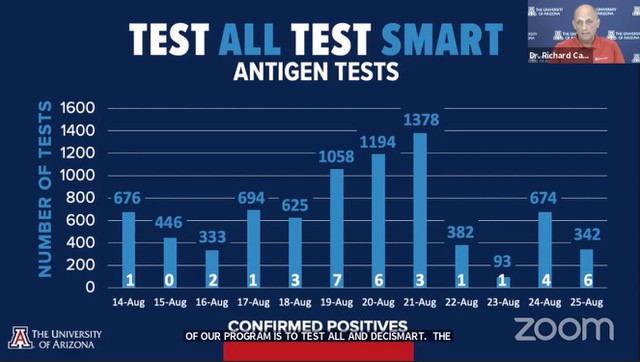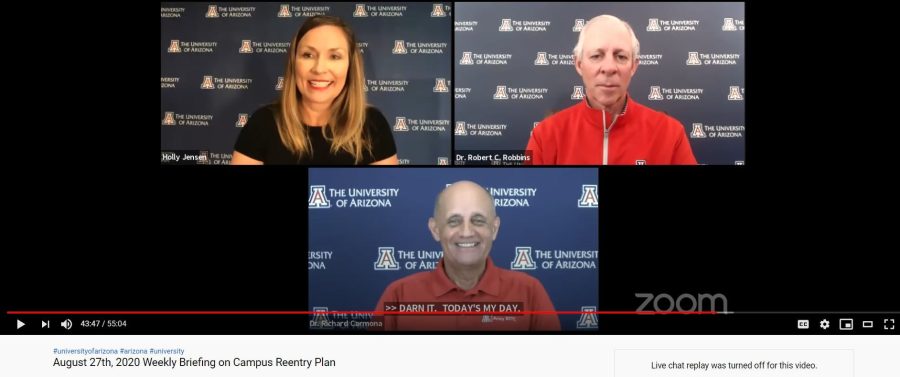The campus reentry task force discussed the early detection of a potential outbreak at the Likins dorm using wastewater testing, some optimistic numbers and their concerns for the coming weeks during the Aug. 28 press conference.
Beginning with an overview of the situation, University of Arizona President Dr. Robert C. Robbins expressed his optimism with the current trends of COVID-19 on campus and in Pima County.
RELATED: UA student emergency fund aids students during pandemic
“The good news is the trend of cases in the community continues to go down,” Robbins said.
He noted that out of over 10,000 individuals tested over the past week or so, only 46 tested positive. Out of the 770 individuals tested yesterday, nine were positive.
Robbins continued by expressing his concern with large gatherings of students not wearing face coverings.
“We’ve had some situations that have been captured on social media about parties that were happening and a couple of the nights this week, I think it was Monday, Tuesday, maybe even Wednesday night, there were large gatherings in the sand beach volleyball courts around Coronado,” Robbins said. “Normally that’d be great, good fun, but unfortunately the people there weren’t covering their face, so we had to take down the nets and put some fencing around it and ask people not to congregate around there.”
Robbins also urged students, faculty and staff to join the 11,000 others who downloaded the COVIDWatch app. Reports show that 5,200 of those users have been completing the wellness check on the app.
With the help of UA professor and environmental microbiologist Ian Pepper, the task force was able to begin wastewater testing in dorms. Through this initiative, the university was able to pick up a signal from the Likins dorm and after testing students in the building, discovered two cases of COVID-19. Those students are now in the isolation dorms.
There have also been 11 cases detected after symptomatic individuals went to Campus Health. Robbins said that one major focus of the testing initiative is discovering cases in asymptomatic individuals.
“What we really need to find out is who are the people who are asymptomatic that are positive,” Robbins said. “This random testing, this use of wastewater-based epidemiology is going to be really important, as well as watching the compliance metrics.”
RELATED: Report: Arizona coaching legend Lute Olson passes away at age 85
Reentry Task Force Director Dr. Richard Carmona added that they are monitoring all states to maintain situational awareness, the main reason being that an influx of “snowbirds” (people who move to Arizona during the cold-weather seasons) into neighboring areas will likely lead to an influx of cases, ICU occupancy and other resources.
“As the snowbirds start moving back, every year without COVID we see a bump in hospitalizations, we see a bump in ICU bed use, because many of our snowbirds would be high risk as it relates to COVID and as we go into the flu season, we see that people come here, they do get sick,” Carmona said. “So we’re always watching bed availability, ICU bed ability, staffing issues, because we have to make sure we’re able to surge if there’s an untoward event on campus that we would need to care for our students staff and faculty.”
Carmona also noted that ventilator use dropped to about 30% this week, down from above 50% in mid-July. Transmissibility of the virus also stayed low and isolation bed use is at 1.2%. Even in light of these promising trends, Carmona expressed his worry with students not complying with social distancing and other COVID-19 best practices.

“I’m optimistic but cautious,” Carmona said. “I think that the numbers have been good. The students, faculty, and staff have been working very hard for us to be able to maintain the level of low transmissibility and health and safety on campus that you have demanded of all of us. Of course, we still are concerned, because after all these are young people not only to be educated, but to stay socially connected.”
Follow Kristijan Barnjak on Twitter









